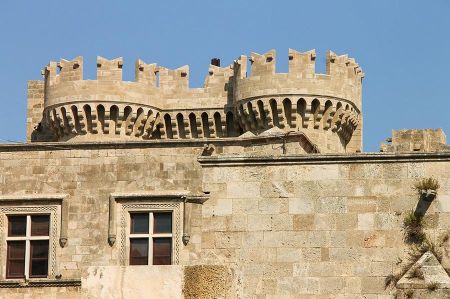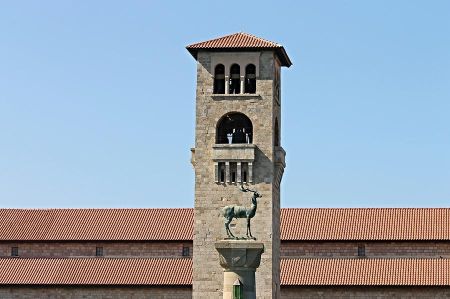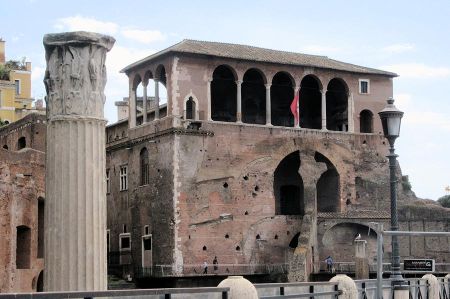The Hospitallers - expansion and consequences to Europe
- Written by Portal Editor
In the first part of our article “The Hospitallers – from the pilgrim hospital in Jerusalem to the conquest of Rhodes” we described their origins as an aid organization for pilgrims until the loss of the “holy land”.
In small steps, during the heyday of the Order of St. John in the Mediterranean, the Knights of the Order also took over the administration of the order's property in the rest of Europe.
A reorganization of the tongues took place in 1301
 Profits earned from the properties were therefore available to the order itself, and in some cases, it was even possible to provide material support to sons of knights who were not entitled to inherit and who had no assets of their own. In some cases, the knights were provided for locally on the basis of benefices, which meant that they were no longer forced to choose a military or ecclesiastical career. However, a conflict of interest quickly became apparent, as the assets generated in the benefices should, if possible, remain in the benefices and no longer be transferred to the order's headquarters.
Profits earned from the properties were therefore available to the order itself, and in some cases, it was even possible to provide material support to sons of knights who were not entitled to inherit and who had no assets of their own. In some cases, the knights were provided for locally on the basis of benefices, which meant that they were no longer forced to choose a military or ecclesiastical career. However, a conflict of interest quickly became apparent, as the assets generated in the benefices should, if possible, remain in the benefices and no longer be transferred to the order's headquarters.
 As early as 1206, so-called “tongues” were formed by national associations of knights in many European states, which in turn were divided into priories, ballies and commends. A ballei could include several comings, which in turn belonged to a priory, a form of organization that lasted until the 18th century. For a certain period of time, the German tongue included Denmark, Norway, Sweden, Hungary and Poland in addition to Germany, Austria and Bohemia. A reorganization of the tongues took place in 1301, which also resulted in a changed hierarchy.
As early as 1206, so-called “tongues” were formed by national associations of knights in many European states, which in turn were divided into priories, ballies and commends. A ballei could include several comings, which in turn belonged to a priory, a form of organization that lasted until the 18th century. For a certain period of time, the German tongue included Denmark, Norway, Sweden, Hungary and Poland in addition to Germany, Austria and Bohemia. A reorganization of the tongues took place in 1301, which also resulted in a changed hierarchy.
French tongue:
 - Grand Priory of France with Northern and Western France; In 1317 divided into the Grand Priories of Aquitaine (Poitiers), Champagne and France
- Grand Priory of France with Northern and Western France; In 1317 divided into the Grand Priories of Aquitaine (Poitiers), Champagne and France
- Provence: includes the south of France with two grand priories in Toulouse and Saint-Gilles
- Auvergne: Central France with the Grand Priory of Bourganeuf
Spanish tongue:
- Includes the Iberian Peninsula with Grand Priories for Aragon (Amposta), Catalonia, Castile and León, Navarre and Portugal
- Division in 1462: the Grand Priories of Amposta, Catalonia and Navarre form the tongue of Aragon;
- the Grand Priories of Castile-León and Portugal form the tongue of Castile
Italian tongue:
 - Includes the Grand Priories of Messina, Barletta, Capua, Rome, Pisa, Lombardy and Venice
- Includes the Grand Priories of Messina, Barletta, Capua, Rome, Pisa, Lombardy and Venice
English tongue:
- Includes England, Scotland and Ireland with the Grand Priories
German tongue:
- Includes the Grand Priories of Bohemia, Upper and Lower Germania, Dacia (= Denmark), Sweden, Poland and Hungary
Development of the Order of St. John in Germany
As early as 1154, the Johanniters had founded their first branch on German soil outside the city walls of Duisburg. Only a little later they built the St. Mary's Church in Duisburg. However, the possessions of the Order of St. John in Germany were and always remained considerably smaller than in neighboring countries. One of the oldest religious houses was founded in 1162 in the Eifel town of Adenau. A little later, Albrecht the Bear donated the church in Werben and the 6 hooves of land associated with it to the Order of St. John. As a result, Werben was the seat of the order's government for Brandenburg, Pomerania and the Wendenland for around 250 years. During the subsequent expansion of the Order of St. John in western Mecklenburg, the Sülsdorf Priory and the Kraak Commandery were added.
 With the ban and the associated expropriation of the Templar Order in 1312, the Templars' possessions in Brandenburg were transferred to the Johanniter Order. The transfer regulations were set out in the so-called Cremmen Treaty on January 23, 1318 by Margrave Waldemar of Brandenburg. In this contract, the Tempelhof Commandery was also transferred, but it was sold by the Johanniters to the cities of Berlin / Cölln in 1435. In the period from 1505 to 1806, the seat of the German Grand Priory of the Johanniter was established in Heitersheim and Maltese institutions are still represented in Duisburg today.
With the ban and the associated expropriation of the Templar Order in 1312, the Templars' possessions in Brandenburg were transferred to the Johanniter Order. The transfer regulations were set out in the so-called Cremmen Treaty on January 23, 1318 by Margrave Waldemar of Brandenburg. In this contract, the Tempelhof Commandery was also transferred, but it was sold by the Johanniters to the cities of Berlin / Cölln in 1435. In the period from 1505 to 1806, the seat of the German Grand Priory of the Johanniter was established in Heitersheim and Maltese institutions are still represented in Duisburg today.
Rhodes and Malta
 Around 1300, the conflicts between the Order of St. John and the King of Cyprus came to a head. A little later, the Grand Master Fulko de Villaret was convinced and ready to conquer Rhodes, which had been poorly developed by Byzantium and was therefore difficult to defend. After initial planning in 1306, de Villaret was able to implement his plan in 1309. After the conquest, major expansion and the construction of huge fortifications began immediately, and a grand master's palace was also built. The Knights of the Order of St. John were able to successfully defend the island against Egyptian attacks for more than 200 years. The expansion of Rhodes into a fortress cost enormous amount of money, so that there were now high demands for loans. Internal disputes and problems in recruiting new knights meant that the Hospitallers had to give up or neglect their activities with regard to the reconquest of Jerusalem or new crusade activities. Now the defense of the Mediterranean against advancing Islamic troops came to the forefront of the Hospitallers' activities as a new task. With the focus on the naval port of Rhodes, a strong Mediterranean fleet was now built up, which became an important power factor in the eastern Mediterranean.
Around 1300, the conflicts between the Order of St. John and the King of Cyprus came to a head. A little later, the Grand Master Fulko de Villaret was convinced and ready to conquer Rhodes, which had been poorly developed by Byzantium and was therefore difficult to defend. After initial planning in 1306, de Villaret was able to implement his plan in 1309. After the conquest, major expansion and the construction of huge fortifications began immediately, and a grand master's palace was also built. The Knights of the Order of St. John were able to successfully defend the island against Egyptian attacks for more than 200 years. The expansion of Rhodes into a fortress cost enormous amount of money, so that there were now high demands for loans. Internal disputes and problems in recruiting new knights meant that the Hospitallers had to give up or neglect their activities with regard to the reconquest of Jerusalem or new crusade activities. Now the defense of the Mediterranean against advancing Islamic troops came to the forefront of the Hospitallers' activities as a new task. With the focus on the naval port of Rhodes, a strong Mediterranean fleet was now built up, which became an important power factor in the eastern Mediterranean.
The Heimbach comparison based on the construction of the Rhodes Fortress
 As already mentioned, the construction of the Rhodes fortress led to high loan demands that could only be repaid through the sale of property. This led to severe economic losses for the friars, who were affected by the sales of their properties. As a result, there were fears among North German knight brothers in particular that they would not be able to cope with further restrictions. Their protest ultimately led to the so-called Heimbach settlement in 1382, which confirmed the general capital of the Order of St. John and gave the Ballei Brandenburg the greatest possible autonomy. Probably the most important further point of comparison was the reduction in the benefits to be paid to the order's headquarters in Rhodes and later to Malta.
As already mentioned, the construction of the Rhodes fortress led to high loan demands that could only be repaid through the sale of property. This led to severe economic losses for the friars, who were affected by the sales of their properties. As a result, there were fears among North German knight brothers in particular that they would not be able to cope with further restrictions. Their protest ultimately led to the so-called Heimbach settlement in 1382, which confirmed the general capital of the Order of St. John and gave the Ballei Brandenburg the greatest possible autonomy. Probably the most important further point of comparison was the reduction in the benefits to be paid to the order's headquarters in Rhodes and later to Malta.
Further attacks on Rhodes
In 1440 and 1444, Rhodes was besieged by Egyptian troops and fleets. The current Grand Master Johann von Lastic himself was able to survive the siege of the capital very successfully. In 1480, the Ottoman Sultan Mohammed II attempted to siege and conquer the city of Rhodes with over 70,000 men, this time the defender was called Grand Master Pierre dÁubusson. Only when the city was besieged for 6 months under the leadership of Sultan Süleyman the Magnificent did the knights of the order have to give up their defensive struggle and surrendered on December 22, 1522. The Grand Master Philippe de Villiers de lÍsle-Adam, who was present at that time, received, as did all the survivors Knights free departure from Rhodes.
Moved to Malta
 After the fortress of Rhodes was abandoned, the Johanniter base was withdrawn. Some of the fleeing knights made it to Crete or retreated to other possessions of the order in Europe. The original task in the Holy Land could no longer be fulfilled. In 1530, Emperor Charles V gave the islands of Malta and Gozo to the knights as a fief, and a little later he also gave Tripoli, which he had conquered. The name Johanniter was now more and more transformed into the name of the Order of Malta.
After the fortress of Rhodes was abandoned, the Johanniter base was withdrawn. Some of the fleeing knights made it to Crete or retreated to other possessions of the order in Europe. The original task in the Holy Land could no longer be fulfilled. In 1530, Emperor Charles V gave the islands of Malta and Gozo to the knights as a fief, and a little later he also gave Tripoli, which he had conquered. The name Johanniter was now more and more transformed into the name of the Order of Malta.
As with Rhodes, the island of Malta was initially heavily fortified. The most important source of money was the attacks and looting of shipping in the Muslim states. The Maltese used the proceeds to build a fleet of war galleys, further strengthened the island's fortifications and also developed naval operations, which of course created new enemies. When Tripoli was lost to the Turkish corsair Turgut Reis in 1551, the seat of Malta also began to wobble. In 1565, Malta was attacked and besieged by the Ottomans, but was able to hold out despite massive losses.
In 1440 and 1444, Rhodes was besieged by Egyptian troops and fleets. The current Grand Master Johann von Lastic himself was able to survive the siege of the capital very successfully. In 1480, the Ottoman Sultan Mohammed II attempted to siege and conquer the city of Rhodes with over 70,000 men, this time the defender was called Grand Master Pierre dÁubusson. Only when the city was besieged for 6 months under the leadership of Sultan Süleyman the Magnificent did the knights of the order have to give up their defensive struggle and surrendered on December 22, 1522. The Grand Master Philippe de Villiers de lÍsle-Adam, who was present at that time, received, as did all the survivors Knights free departure from Rhodes.
 The defence of possessions in the Mediterranean as well as the relocation from Rhodes to Malta and the protection of Christian merchant shipping had severely affected the fortunes of the Order of St. John. The progressive Reformation in Europe also added to this due to a weakening of personnel. When the Anglican Church split off in 1534, the tongues in England were also lost. The German tongue also became weaker as the Ballei Brandenburg adopted the Protestant denomination in the course of the Reformation.
The defence of possessions in the Mediterranean as well as the relocation from Rhodes to Malta and the protection of Christian merchant shipping had severely affected the fortunes of the Order of St. John. The progressive Reformation in Europe also added to this due to a weakening of personnel. When the Anglican Church split off in 1534, the tongues in England were also lost. The German tongue also became weaker as the Ballei Brandenburg adopted the Protestant denomination in the course of the Reformation.
Another article on the history of the Order of Malta and the then Protestant Order of St. John will follow shortly.
Please also read:
